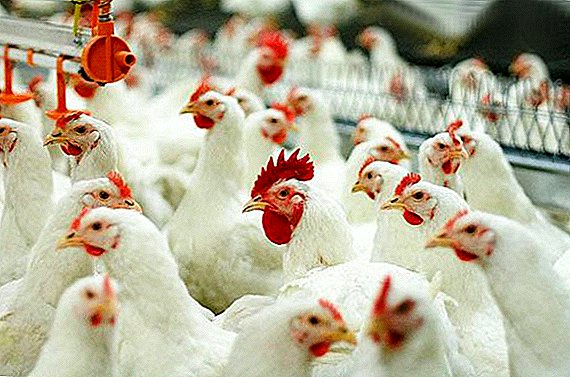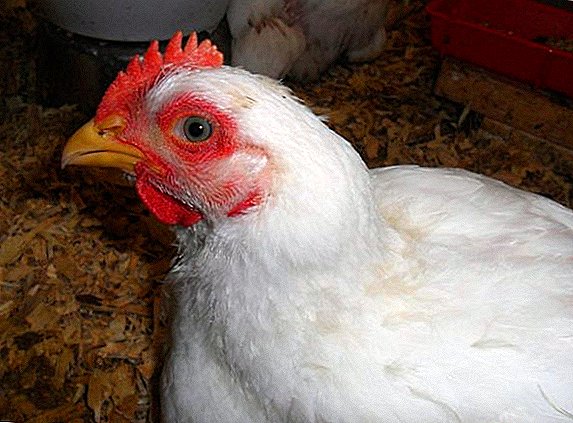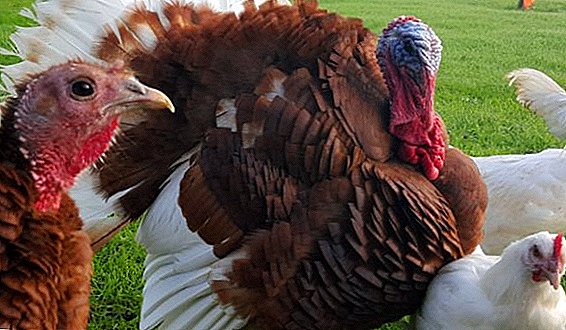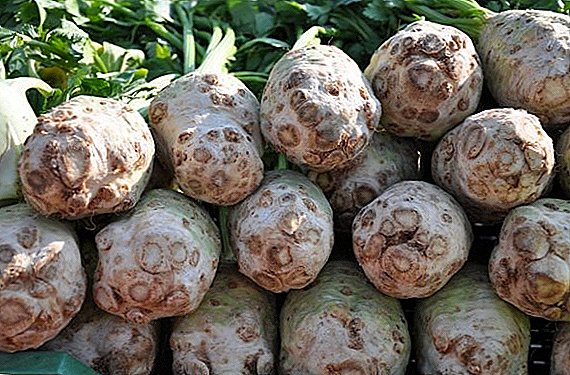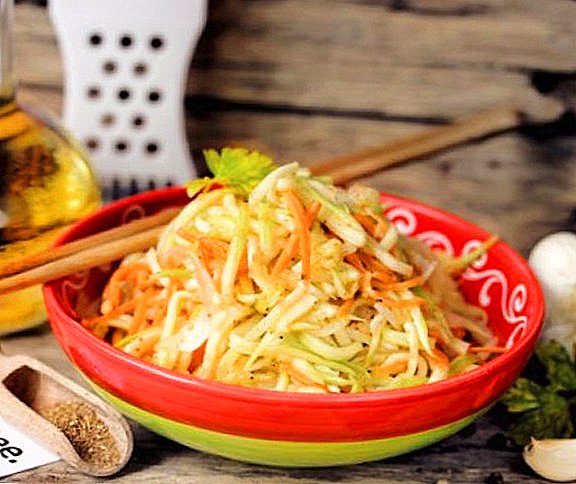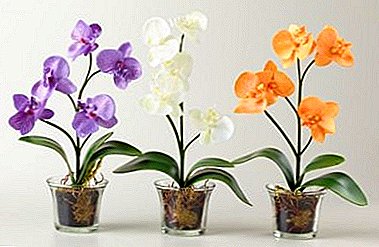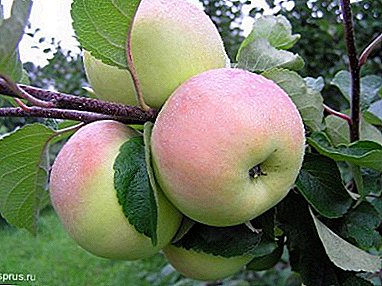
Bolotovsky apple - a well-known dessert variety of Oryol breeding, encountered in gardening as often as new winter hardy varieties.
Valued for excellent taste, good keeping quality of fruits, stable yields, allowing farmers to rely on annual profits.
Apples are consumed fresh, dried, used to make juices, jams, preserves, compotes. Description and photo of apple varieties Bolotovskoe in the article.
What kind is it?
 Apple Bolotovskoe - frost-resistant, winter, with good immunity gradewhich has the Vf gene, making the apple immune to the scab pathogen. Yield.
Apple Bolotovskoe - frost-resistant, winter, with good immunity gradewhich has the Vf gene, making the apple immune to the scab pathogen. Yield.
From 1997 to 2002 he was tested according to the program of state tests. In 2002, entered into the State Register.
For the winter varieties of apple trees also include: Zavetny, Lada, Persiyanka, Rossoshansky and Moscow Jubilee.
Pollination and storage
The apple tree Bolotovskoe is self-productive. The best pollinator varieties are autumn and winter varieties.
To increase the shelf life (up to 5 months from the date of removal), the fruit is placed in the refrigerator.
Properly selected humidity and temperature in the storage will ensure the Bolotovsky apples preserve the original taste and consumer appeal throughout the shelf life.
Description of the variety Bolotovsky
Crohn in specimens that are not subjected to pruning branches, closer to the spherical with a slight expansion in the upper part. The basic branches deviate from each other during development, therefore the crown is not dense.
 Tree height above the average. Saplings grow quickly, and the root system and the above-ground part of the tree develop simultaneously.
Tree height above the average. Saplings grow quickly, and the root system and the above-ground part of the tree develop simultaneously.
Trunk trunk and branches with smooth bark. Shoots brownish color, with a small percentage of the edge, faceted in cross section.
A larger percentage of the green mass of trees of the Bolotovsky apple variety is represented by large dark green leaves of slightly elongated shape.
Veins are well viewed, abundant, rough, because of what the foliage looks wrinkled. The surface of the leaves, sitting on thick and strong petioles, brilliant. The edges are serrate-crenate, the upper part is prone to twisting.
Flowers on long stalks, saucer-shaped with rounded petals, white, pinkish in the stage of developing buds. When opening the petals are located separately. The anthers rise above the stigmas, the column of the pistil is not trimmed.
Fruit taste sweet and sour, pleasant, deliciousThat is why Bolotovskoe apple belongs to dessert varieties. Fruits are large, flattened, weighing up to 160 g.
The following varieties can also boast excellent taste: Orlovsky Pioneer, Ekranny, Bolshaya Narodnoe, Orlinka and Aromatny.
Wide ribbed, at the stage of technical maturity greenish-yellow or light yellow with a white tint.
At full ripeness, a distinct pink-red blush appears on the peel, formed by numerous stripes and specks. The surface of the peel is oily and does not have wax.
Juicy flesh has a good density, pale green hue. The stem is sturdy, thick, straight.
In a section it is visible, that the funnel of average depth, narrow. Taste score on a five-point scale - 4, 27, external consumer appeal - 4, 3 points.
A photo




Breeding history
Hybrid variety, cultivated since 1977. Received thanks to the efforts of the All-Russian Research Institute, which worked in Orel. V. V. Zhdanov, Z. M. Serova, Yu. I. Khabarov is a team of scientists headed by an academic Yevgeny Nikolayevich Sedymwho worked on breeding variety Bolotovsky.
In breeding work, the variety Skryzhapel and apple tree 1924 were used.
Region of growth and distribution
 Variety adapted to the conditions of cold winters and is recognized as suitable for industrial cultivation in climatic conditions characteristic of Central Black Earth region.
Variety adapted to the conditions of cold winters and is recognized as suitable for industrial cultivation in climatic conditions characteristic of Central Black Earth region.
Carries frosts to-38C. At -42C young shoots are damaged.
Suitable for growing in regions with warmer climates, for example, in the southern regions of the Russian Federation, Ukraine.
Also for planting in this region are suitable varieties: Golden Delicious, Malinovka, Starkrimson, Uslada and Kvinti.
Yield
Productivity is stable, with favorable climatic conditions annually (if during the mass flowering there were no frosts or prolonged rains).
IMPORTANT! Delay in harvesting can lead to significant losses of fruits suitable for further storage or sale as a fresh product, as apples begin to fall off in large quantities.
Active fruiting starts from 7-8 years development of grafted seedlings.
One adult tree is able to give up to 200 kg of apples per season. Technical maturity of the fruit falls in the middle of September.
Excellent yields are demonstrated by such varieties: Winter Hrushovka, Shtriel, Aloe Early, Marat Busurin and Antonovka ordinary.
Planting and care
Agrotechnics growing apple varieties Bolotovskie typical for culture.
 Seedlings planted in open ground at the beginning / middle / end of the second month spring or autumn - a month - one and a half before the onset of cold nights with frost on the ground.
Seedlings planted in open ground at the beginning / middle / end of the second month spring or autumn - a month - one and a half before the onset of cold nights with frost on the ground.
Choosing a place for planting a Bolotovsky apple sapling in a small garden, preference is given to areas sunnyaway from areas with close groundwater.
Fertilizers introduced into the planting pit (compost, humus, peat, potassium sulphide, superphosphate, ash) will provide the seedling with full nutrition throughout the first year of growth.
Everything a young tree needs in the next twelve months after planting is timely watering, loosening, protection from rodents and insects.
Bolotovsky apples quite unpretentious in the care. By ensuring proper agrotechnology for trees at a young age, the grower automatically reduces the amount of problems that arise with trees that have a fragile "health" due to lack of care during the first five-year growth period.
Basic elements of the required agrotechnology:
- Timely tillage (loosening after rain and watering, removal of weeds).
- The introduction of complex fertilizers, starting from the second year of development (taking into account the composition of the soil).
- Removal of damaged branches.
- Formation of the crown after stopping sap flow.
- Protection of the trunk from rodents in the winter (tying the lower part of the trunk with coarse bark from a healthy tree, wire mesh over a layer of reeds, straw).
- Preventive measures against burns of the trunk and skeletal branches (strapping with hessian, whitewash).
- Spraying against caterpillars, sawyers, ants and other insect pests.
Diseases and pests
Bolotovsky apple trees have innate immunity to microorganisms that cause //selo.guru/ptitsa/bolezni-p/gribkovye/parsha.html.
Other types of ailments that can affect apples:
- Mealy dew.
- Cytosporosis.
- Bacterial burn.
- Milky shine.
- Fruit rot.
- Black cancer
 Vs powdery mildew, the initial manifestation of which is diagnosed by the appearance of off-white bloom on the foliage, spraying with Topaz or Bordeaux liquid during foliage dissolution, after flowering and after harvesting, helps.
Vs powdery mildew, the initial manifestation of which is diagnosed by the appearance of off-white bloom on the foliage, spraying with Topaz or Bordeaux liquid during foliage dissolution, after flowering and after harvesting, helps.
Cytosporosis - fungal disease, which affects the bark of apple trees, does not touch trees that received a spraying of Hom (copper chlorine) three times in a season.
Bacterial burn develops against the background of the attack of young seedlings of a bacterial pathogenic culture. From it the foliage turns black and dries.
In order not to become an unwitting source of infection of already existing trees in the area, do not bring unhealthy planting materials with damaged, blackened foliage.
Developmental prevention milky shinewhich is manifested by air bubbles on the leaves and dark spots on the trunk, is the regular feeding of trees with the necessary microelements, a neat pruning of the branches followed by putty of the caused wounds.
Vs fruit rotthat turns apples into an inedible and unappealing product, helps the same drug Hom.
 Black cancer determined by inverted, cracked wood and an abundance of dark spots on the foliage. A preventive measure is to combat bark beetles that weaken crops and increase the risk of developing the disease.
Black cancer determined by inverted, cracked wood and an abundance of dark spots on the foliage. A preventive measure is to combat bark beetles that weaken crops and increase the risk of developing the disease.
A radical measure is the pruning of the affected areas, followed by the sealing of "penechki", spraying of copper sulfate after flowering ceases.
The main types of pests of apple trees:
- Listovertka (protected by a solution of nitrophen or chlorophos).
- Aphid (fighting karbofos, tobacco infusion).
- Red tick (help get rid of dicofol, karbofos).
- Apple mole (scare solution of chlorophos or zolone).
- Flower (the same drugs as for the fight against red tick).
- Moth (the same drugs as for the fight against red tick).
Despite the fifty-year history and a large number of competitors from among the new varieties, the Bolotovsky apple is still popular among gardeners.
Since the grade frost resistant, impervious to scab pathogens, and fruits are tasty, well preserved, are a demanded product for the productions which are engaged in release of juice and jams.
Watch the video about apple variety Bolotovskoe.



